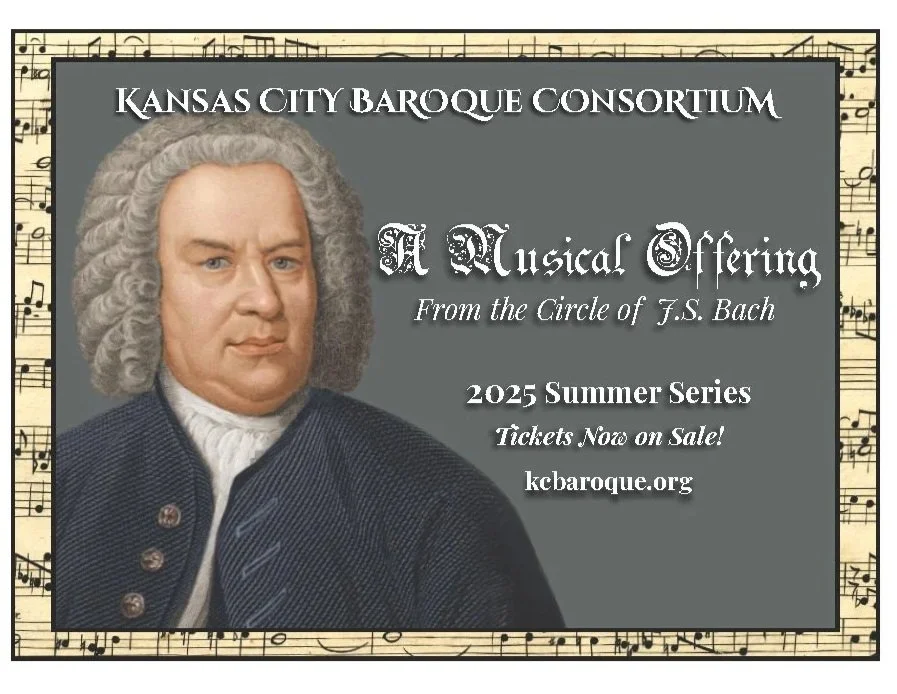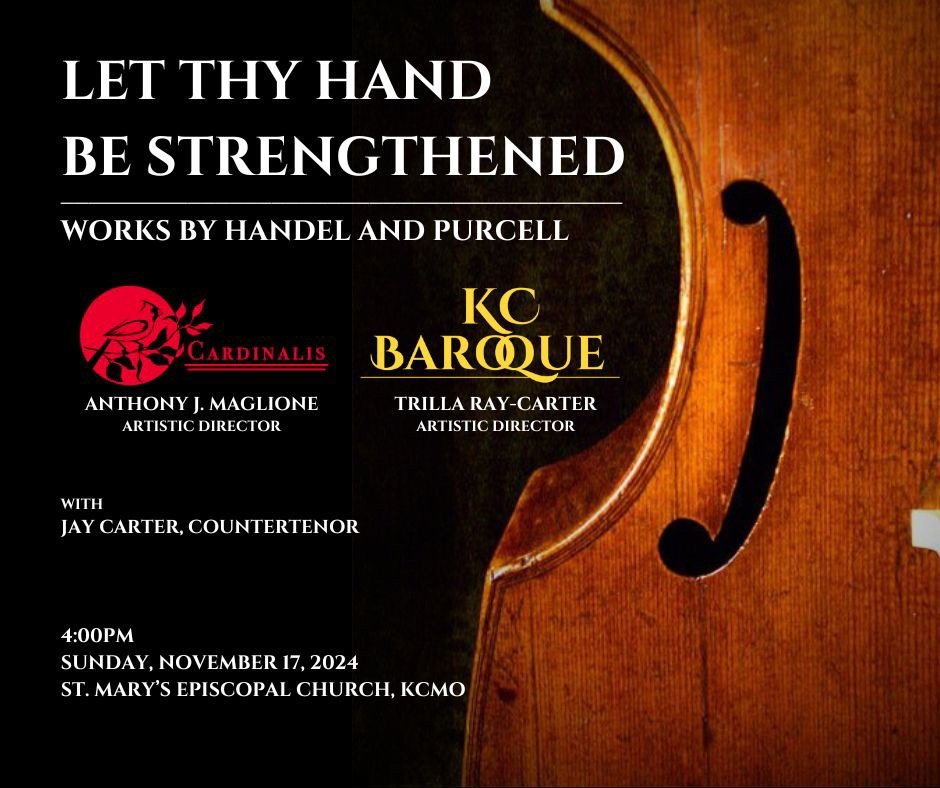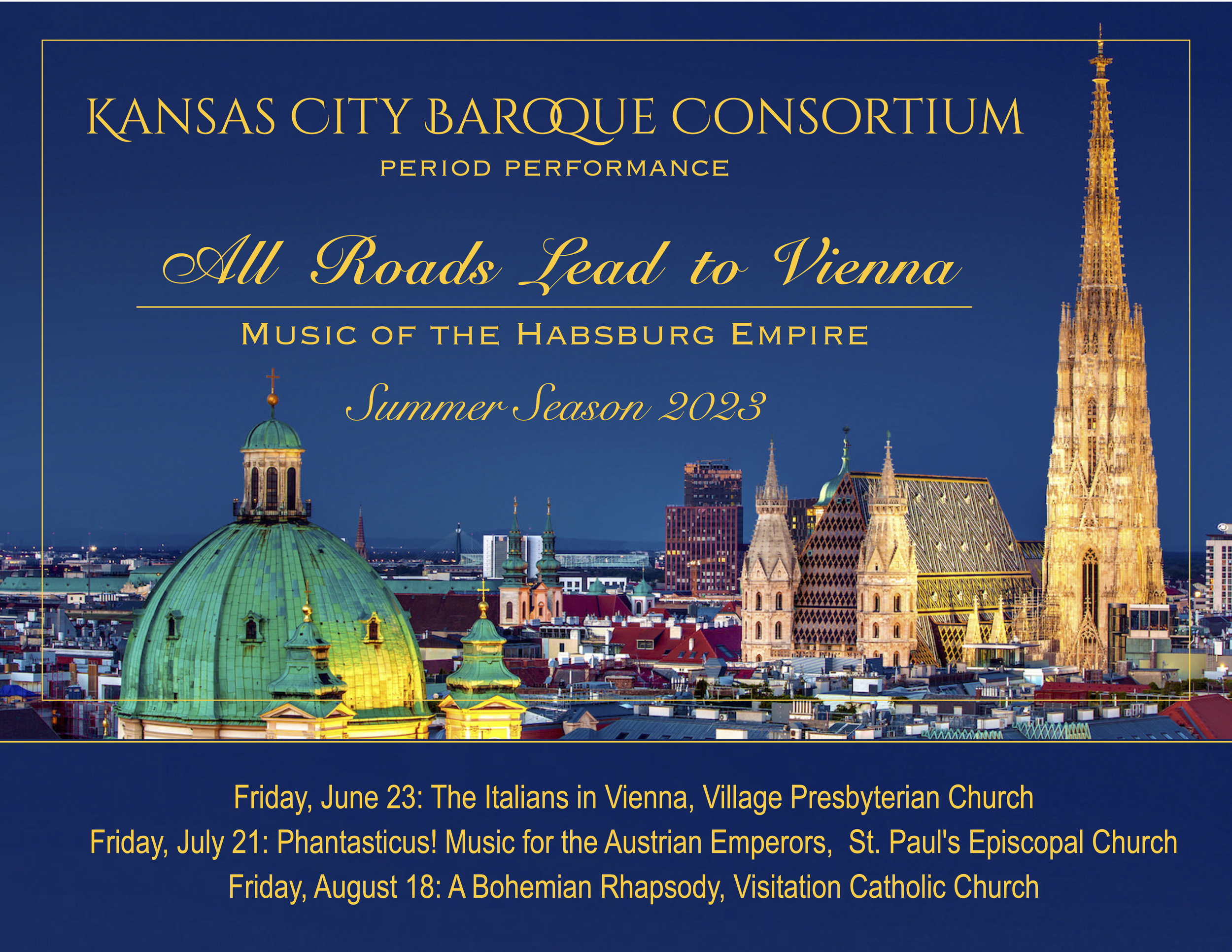KC Baroque presents an annual Summer Series along with occasional collaborative concerts with Kansas City ensembles. Click HERE to learn more about upcoming performances.
Explore Past Concerts:
Summer Series 2025: A Musical Offering - From the Circle of J.S. Bach
Fall 2024: Let Thy Hand Be Strengthened
Summer Series 2024: Pearls of the Baroque
Summer Series 2023: All Roads Lead to Vienna
Concerts from the Archives
~ Excerpts from past performances are available on YouTube ~
Summer 2025
Summer Series 2025 Overview
Concert I: Bach & Co.: Music of JS Bach and His Contemporaries
Buxtehude, Graupner, & Telemann
Friday, June 27, 7:30 p.m.
St. John’s United Methodist Church
&
Sunday, June 29, 3:00 p.m.
Gloria Dei Lutheran Church
~ ~ ~
CONCERT II: Bach & His Boys: Music from the Bach Family Dynasty
PROGRAM NOTES from Eric Williams, KC Baroque Player
Friday, July 18, 7:30 p.m.
Village Presbyterian Church
&
Sunday, July 20, 3:00 p.m.
Gloria Dei Lutheran Church
~ ~ ~
Concert III: Bach at the Café Zimmerman: Coffee, Pipe, & Drink: Vice, Virtue & Redemption
featuring Jay Carter, countertenor
Friday, August 15, 7:30 p.m.
Visitation Catholic Church
&
Sunday, August 17, 3:00 p.m.
Gloria Dei Lutheran Church
fall 2024
Cardinalis and KC Baroque
present
LET THY HAND BE STRENGTHENED
Music of Handel & Purcell
Sunday, November 17th, 4:00 PM
St. Mary's Episcopal Church
summer 2024
Summer 2024 Overview
CONCERT I: Friday, June 28, 2024
featuring Jay Carter, Countertenor
Music of Vivaldi, Corelli, Caldara and Geminiani
St. John’s United Methodist Church
6900 Ward Parkway, Kansas City, MO 64113
~ ~ ~
CONCERT II: Friday, July 19, 2024
featuring Hannah De Priest, Lyric Soprano
Music of Handel and Vivaldi
Country Club United Methodist Church
400 W. 57th, Kansas City, Missouri 64113
~ ~ ~
CONCERT III: Friday, August 16, 2024
featuring Daniel Lee - violin, David Hays, violin,
Trevor Stewart, recorder, Rachel Siegel, recorder
Music of Vivaldi, Telemann,
and J.S. Bach’s Brandenburg Concerto No. 4
Visitation Catholic Church
5141 Main Street, Kansas City, Missouri 64112
~ ~ ~
A Note about the Image above:
The oil painting of a girl in a turban with a pearl earring was painted in 1665 by Dutch painter Johannes Vermeer (1632-1675), “Girl with a Pearl Earring” is one of only 36 of his known paintings. For this work, Vermeer utilized the color ultramarine, a rare pigment made of lapis lazuli which was more expensive than gold during the 17th century. Ultramarine is an intense color used not only for this girl’s turban, but also for her clothes’ shadows. The work is one of contrasts: of brilliant light and darkness, of soft beauty and stark lighting, and of opalescence (the pearl) and simplicity. As such, the drama and luxury depicted in “Girl with a Pearl Earring” encapsulates similar characteristics of the Baroque period. In fact, the term “Baroque” is derived from the Portuguese barroco, which means “oddly-shaped pearl.” Figuratively, it can mean ornate, elaborate, or extravagant.
summer 2023
KC Baroque is recognized for its dedication to lifting the veil of obscurity on some of the most significant, yet rarely performed composers of the Baroque era. We look forward to welcoming audiences into this remarkable era of music that is full of fantasy, virtuosic delight, and unexpected charm!
Summer Series 2023
All Roads Lead to Vienna: Music of the Habsburg Empire
The Hapsburgs, one of Europe’s most extraordinary dynasties, ruled greater or lesser portions of Europe from the 11th century until 1918. Its zenith coincided with the extraordinary musical flourishing of the 16th, 17th and 18th centuries. Vienna, the “imperial city” for the Empire, became a melting pot of culture and music. In our 2023 Summer Series we explored the music that played vital roles in Habsburg Courts of the 17th and 18th centuries, from the preference for Italian music at the Imperial Court of Vienna to music for Austrian Holy Roman Emperors, to the remarkable works of the outliers – the Bohemian court composers we rarely hear today.
I: Friday, June 23, 2023
The Italians in Vienna
Village Presbyterian Church, 6641 Mission Road, Prairie Village, KS
Music of Vivaldi, Bononcini, Bonporti, Valentini and Cesti
•••
II. Friday, July 21, 6:15pm - Pre-concert chat with Dr. Anya Pogorelova
7:30pm: Phantasticus! Music for the Austrian Emperors
St. Paul's Episcopal Church, 40th and Main Street, Kansas City, MO
•••
III: Friday, August 18, 7:30 pm
A Bohemian Rhapsody
Visitation Catholic Church, 5141 Main Street, Kansas City, MO
Music of Zelenka, Finger, Tuma, and Muffat
•••
While Vienna was being charmed by the Italian composers, Austrian composers were busy serving the Holy Roman Emperors outside of Vienna embracing and developing a musical language brought north by the Italians that we have come to refer to as the ‘Fantastic Style’, or as the Austrians called it, Stylus Phantasticus. The composers of the 17th century are carving a musical path that will eventually lead us to the balanced and refined architecture we find in the 18th century. This is music that is free and impulsive, intensely vivid, lavish, rhetorical and theatrical! Join us for a fantastic journey with music performed for the Holy Roman Emperors by the greatest of the Austrian, German and Italian composers of the day!
archive performances
More from our Archives:
The Fashionable Chalumeau
Telemann, the Cosmopolitan
Music in Colonial America
Archive Performances: Anthony Maglione’s ,“I Am Silent”



